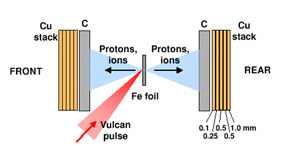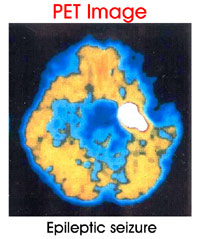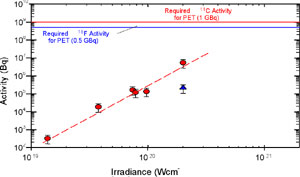 This visionary field of research started when ultra-intense laser light was focused on to solids producing high brightness and highly collimated beams of energetic electrons, photons, protons, neutrons and heavy ions. The total electricity generated in America is approximately a terawatt and modern ultra-intense short pulse lasers have pulse powers of petawatt (1000 terawatt). It is not surprising that amazing new physical conditions are created when such intensities are focussed down to dimensions of a human hair - these are the conditions that naturally exist in stars.
This visionary field of research started when ultra-intense laser light was focused on to solids producing high brightness and highly collimated beams of energetic electrons, photons, protons, neutrons and heavy ions. The total electricity generated in America is approximately a terawatt and modern ultra-intense short pulse lasers have pulse powers of petawatt (1000 terawatt). It is not surprising that amazing new physical conditions are created when such intensities are focussed down to dimensions of a human hair - these are the conditions that naturally exist in stars.
 Ultra-intense lasers create electric fields 1000 times greater than conventional accelerators allowing one to miniaturise these and permitting table-top nuclear physics to be carried out. The Universities of Glasgow and Strathclyde carried out the first experiments on laser induced fission of uranium and the team were first to generate laser induced medical PET isotopes in clinically significant quantities: first to demonstrate laser induced heavy ion fusion reactions, first to demonstrate laser induced transmutation of radioactive waste and first to demonstrate laser induced spallation of neutrons. Strathclyde and UWS have been involved in a very fruitful collaboration; UWS have a world-wide reputation in studying heavy ions for nuclear structure. It is this partnership of excellence that has allowed SUPA to mount the new experiments that link heavy ion accelerators and petawatt lasers for the first time at GSI Darmstadt in Germany as well as to proceed with the other experiments described below.
Ultra-intense lasers create electric fields 1000 times greater than conventional accelerators allowing one to miniaturise these and permitting table-top nuclear physics to be carried out. The Universities of Glasgow and Strathclyde carried out the first experiments on laser induced fission of uranium and the team were first to generate laser induced medical PET isotopes in clinically significant quantities: first to demonstrate laser induced heavy ion fusion reactions, first to demonstrate laser induced transmutation of radioactive waste and first to demonstrate laser induced spallation of neutrons. Strathclyde and UWS have been involved in a very fruitful collaboration; UWS have a world-wide reputation in studying heavy ions for nuclear structure. It is this partnership of excellence that has allowed SUPA to mount the new experiments that link heavy ion accelerators and petawatt lasers for the first time at GSI Darmstadt in Germany as well as to proceed with the other experiments described below.
At present there are petawatt lasers at RAL and Aldermaston in the UK and in Japan, France, Livermore, Rochester, Korea, China and GSI, but it is only at the Rutherford Laboratory that one can carry out our laser nuclear experiments at present and this gives our team a unique window of opportunity. Aldermaston (AWE) constructed a laser complex with two petawatt lasers in 2007 and we expect greatly increased collaboration with AWE within the next few years.
The excitement of this field is that one can carry out both fundamental nuclear/plasma physics/astrophysics/ fundamental particles studies as well as applications in a number of areas e.g. medicine, and material physics. The areas on which Strathclyde/UWS are concentrating are:
- Linking petawatt lasers to heavy ion physics carried out at GSI.
- Rutherford Laboratory has attained the highest magnetic fields ever produced in a lab (>300 Megagauss). As these lasers become scaled to multi-petawatt and even exawatt levels then multi-gigagauss fields will be generated in the lab. These are the conditions that exist on white dwarfs and even black holes. For the first time stellar conditions can be created in the lab.
 Table top nuclear physics for PET isotope production as well as developing laser driven proton and heavy ion oncology. This is also at present being carried out at GSI and hence this is another opportunity of synergy with that laboratory. We are developing laser induced neutron therapy on a table-top which can only at present be carried out at reactors or accelerators. This work is carried out collaborating with the Paterson Cancer Centre in Manchester.
Table top nuclear physics for PET isotope production as well as developing laser driven proton and heavy ion oncology. This is also at present being carried out at GSI and hence this is another opportunity of synergy with that laboratory. We are developing laser induced neutron therapy on a table-top which can only at present be carried out at reactors or accelerators. This work is carried out collaborating with the Paterson Cancer Centre in Manchester. - We published the first paper on laser transmutation of 129I and there are a number of other isotopes to study e.g. 99Tc and 135Cs. We have established a programme of laser nuclear transmutation studies and neutron spallation that can presently only be carried out on large reactor and accelerator facilities, collaborating with the Institute of Transuranium Elements in Karlsruhe, Germany.
